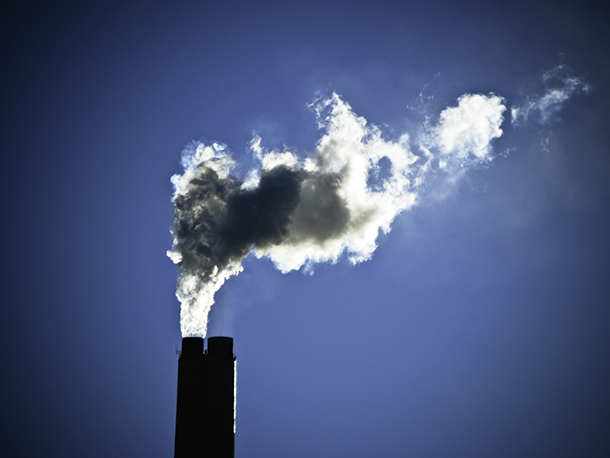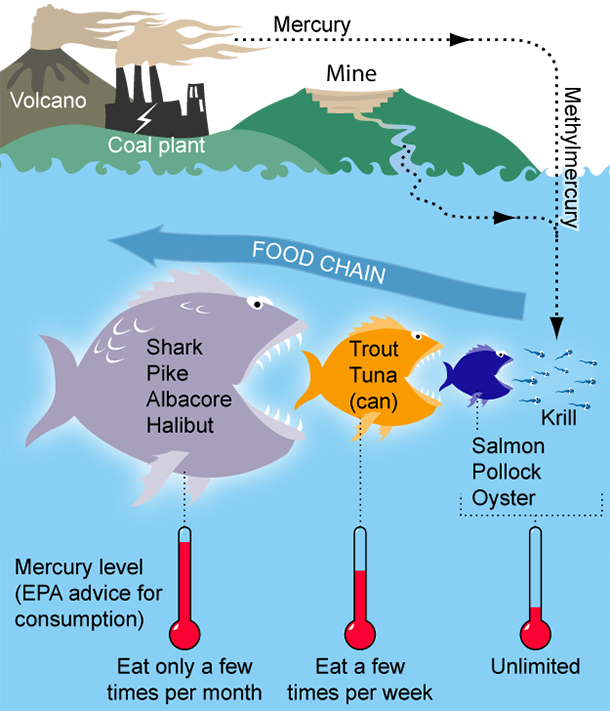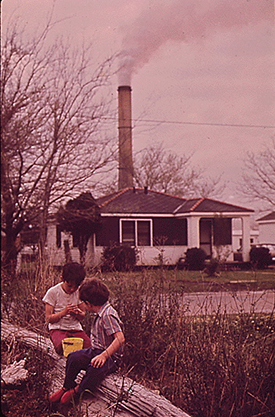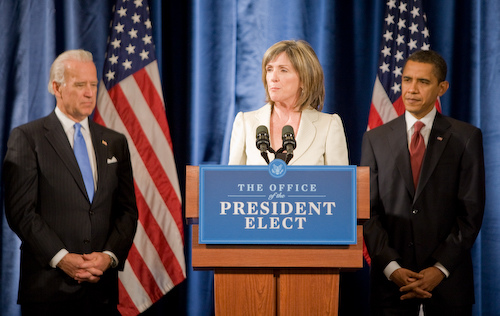The Supreme Court Blocks EPA's Mercury Rule --For Now
Air Date: Week of July 10, 2015

Coal-fired power plants emit more than half of the total US airborne mercury emissions. (Photo: Nick Humphries, Flickr CC BY-NC-ND 2.0)
The EPA has been trying for years to limit pollutants from power plants. But the proposed rule to cut toxic mercury was challenged by industry and the case argued up to the Supreme Court, which ruled that EPA did not appropriately take account of costs. But as Former EPA Administrator Carol Browner tells host Steve Curwood, while the ruling is disappointing, the EPA can amend the mercury rule to better consider cost and continue to push for strong regulation. Vermont Law Professor Pat Parenteau also explains the legal details.
Transcript
CURWOOD: From the Jennifer and Ted Stanley Studios in Boston and PRI, this is Living on Earth. I’m Steve Curwood. By the narrowest of margins, 5 to 4, the US Supreme Court recently pushed back against federal rules that would require power plants to clean up their emissions of the toxic metal, mercury. Writing for the majority, Antonin Scalia said the Environmental Protection Agency had failed to consider the cost of the clean up early enough in its rule making process. A lower court will decide if EPA can fix the defects or if the mercury rule must be thrown out entirely. The decision is being closely watched as a precedent for the lawsuits that are expected when rules limiting power plant emissions of global warming gases are issued later this summer. Carol Browner was head of the EPA during the Clinton Administration when mercury rules were first proposed, and she joins us now. Welcome back to Living on Earth.
BROWNER: Thank you. Nice to be here.
CURWOOD: So how might this decision affect EPA's authority to regulate mercury emissions from power plants?
BROWNER: Well, I think it's an unfortunate decision in that EPA has to go back and do it over again. I think that the good news is that states had set mercury standards--industry had started to shut off, retire some of the older facilities. You know, it's a narrow decision, but nevertheless EPA's going to have to go back and sort of redo some of the work.

Mercury is an element that bioaccumulates, or builds up in the body faster than the organism can get rid of it. Bioaccumulation of mercury occurs in humans as well as animals and is especially prevalent in certain fish species, including tuna, marlin, and swordfish. (Photo: Bretwood Higman/Ground Truth Trekking, Wikimedia CC BY 3.0)
CURWOOD: So what are the implications of the court's decision that only so-called "direct benefits" can be considered? I mean how might this influence the case for limiting EPA's power plant rules regarding carbon dioxide, for example?
BROWNER: Well, I think EPA's ability to regulate carbon pollution from power plants, it's a different section than the section of the law that the Supreme Court looked at with regards to mercury, but it is true that when you regulate one pollutant you require a scrubber or some technology to be put on a smokestack, you frequently get reduction in other pollutants. That's good news, and in this case there were significant fine particle reductions in addition to the mercury reductions. And the court seems to be suggesting that you can't count those benefits. I think in the case of carbon pollution, the consequences, the cost to our health, to our environment of carbon pollution are so high that any sort of cost-benefit analysis should be fine.
CURWOOD: What's the mood inside the EPA and the White House in response to this ruling do you think?

Mercury is especially toxic for children because it impairs neurological development, affecting cognitive thinking, memory, attention, language, and fine motor and visual spatial skills. (Photo: John Messina, CC government work)
BROWNER: Well, I think the EPA, the White House, the justice department obviously disappointed. This was a hugely important case from their perspective. The Solicitor General actually argued the case. It's good news that it's a very narrow decision. It simply says, “EPA, yes you looked at cost but you should've looked at it earlier in the decision-making process”. Under this statute, this section of the Clean Air Act, there’s sort of a two-step process: first you look at the science...mercury...is it dangerous to people, how dangerous is it, and then what EPA did is looked at all the power plants that emit mercury and there are many different types of power plants on a sort of type-by-type basis, set standards based on how much it would cost. And in some instances they said you're not going to have to do anything because it's not cost-effective, so they did look at cost, they looked at it endlessly. What Scalia and the majority are saying is you should have looked at cost in the first decision, in the science decision.
CURWOOD: You know, this decision reminds me of a scene from the Greek myth, the myth of Sisyphus. The guy is trying to roll this rock all the way uphill, he gets just to the top and it rolls back. The US government's been trying to regulate mercury since you were running the EPA back during the Clinton administration. What's going on here?
BROWNER: It's been a long road, the efforts to regulate mercury. We focused on smaller sources - that's the way the law works - you start with the smaller incinerators and work your way up to the largest which are the power plants, and the Bush administration could've easily continued the work I had begun. They chose not to follow the path. They lost in court. And then the Obama administration, Lisa Jackson, came back and said OK, we're going to go back to sort of where Browner was and move forward. It's been a lot of time and I think that's extremely unfortunate, but I think it's also a testament to how complicated and thoughtful these decisions are.
CURWOOD: While you were EPA administrator, you took pretty tough actions to eliminate pollution from smog and particulates. What were the legal challenges to getting those rules passed and how did the EPA go about quantifying cost and benefits back then, especially indirect benefits?

For two years during the Obama Administration, Carol M. Browner served as advisor to the President on Energy and Climate Change Policy. Previously, Browner served as EPA Administrator during both terms of Clinton’s Presidency. (Photo: Obama-Biden Transition Team, Wikimedia CC BY 2.0)
BROWNER: Well, interestingly, Scalia, who wrote the majority opinion on mercury, also wrote a majority opinion reviewing the pollution standards that I set, the soot and smog standards, and in that case it was a 9-0 ruling and he agreed with our argument that we didn't have to take cost into effect in setting these ambient air quality standards because what Congress had told us to do was set a public health standard based on the best available science. Now, it's a different section of the law, but obviously was a very important win for EPA because industry argued, no you should be setting it based on how much it's going to cost us, to reduce our pollution and whether the benefits of cleaner air exceed those costs to industry. And in that case, the court said, no, they’ve done it the right way. In this case they're saying, yes, you looked at costs, but you should've looked at it earlier in the process. And I think the concern we should all have is that if we move towards setting environmental pollution standards, workplace safety, whatever...car safety standards on a cost-benefit analysis we may not get the kind of important science-based standards that have brought us safety and cleaner air and cleaner water because when you look at cost before you actually regulate a pollutant, for example, you're guessing what the technology’s going to be and the costs inevitably are higher and they turn out to be once the standard to set because American innovation and ingenuity find a cheaper solution.
CURWOOD: What are the next steps the EPA will be taking to implement a mercury emissions rule given industry’s propensity to say it's going cost too much?
BROWNER: Well, I think this case is very interesting because when EPA goes back to the rule there will be objective cost numbers available because so many plants are already complying with the mercury requirements. So here they're going to have very realistic numbers. That is not a usual turn of events obviously.
CURWOOD: And by the way what is the status of this rule today if I were running up a power plant? Do I have to limit mercury or not while this legal wrangling continues?

Pat Parenteau is a professor at the Vermont Law School, where he teaches on environmental litigation. (Photo: Vermont Law School)
BROWNER: So some states separately have mercury requirements in place and so those would obviously continue, and a number of plants have shut down in anticipation of these requirements. So the actual consequence of this may be small but my sense is EPA will move quickly to fix the situation.
CURWOOD: Carol Browner was EPA's Administrator during President Clinton's term, and former assistant to President Obama for energy and climate change. She now chairs the League of Conservation Voters. Thanks so much for taking the time with us today.
BROWNER: Thank you.
CURWOOD: And there’s a discussion with Vermont Law Professor Pat Parenteau on the legal issues of the Supreme Court decision and its implications at our website, LOE.org.
Listen to our discussion with environmental law professor Pat Parenteau:
stream/download this segment as an MP3 file
Links
High Court Strikes Down EPA Limits on Mercury Emissions
MATS Rules Declared Invalid in Michigan v. EPA, 5-4
The Supreme Court throws a wrench in the EPA’s crackdown on mercury pollution
Supreme Court Majority Opinion by Justice Scalia
EPA’s Regulatory Impact Analysis for the Final Mercury and Air Toxics Standards
Listen to our previous discussion with Pat Parenteau on the mercury rule
Living on Earth wants to hear from you!
Living on Earth
62 Calef Highway, Suite 212
Lee, NH 03861
Telephone: 617-287-4121
E-mail: comments@loe.org
Newsletter [Click here]
Donate to Living on Earth!
Living on Earth is an independent media program and relies entirely on contributions from listeners and institutions supporting public service. Please donate now to preserve an independent environmental voice.
NewsletterLiving on Earth offers a weekly delivery of the show's rundown to your mailbox. Sign up for our newsletter today!
 Sailors For The Sea: Be the change you want to sea.
Sailors For The Sea: Be the change you want to sea.
 The Grantham Foundation for the Protection of the Environment: Committed to protecting and improving the health of the global environment.
The Grantham Foundation for the Protection of the Environment: Committed to protecting and improving the health of the global environment.
 Contribute to Living on Earth and receive, as our gift to you, an archival print of one of Mark Seth Lender's extraordinary wildlife photographs. Follow the link to see Mark's current collection of photographs.
Contribute to Living on Earth and receive, as our gift to you, an archival print of one of Mark Seth Lender's extraordinary wildlife photographs. Follow the link to see Mark's current collection of photographs.
 Buy a signed copy of Mark Seth Lender's book Smeagull the Seagull & support Living on Earth
Buy a signed copy of Mark Seth Lender's book Smeagull the Seagull & support Living on Earth

